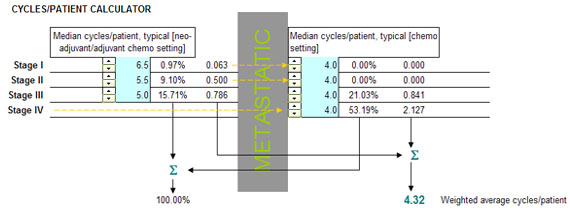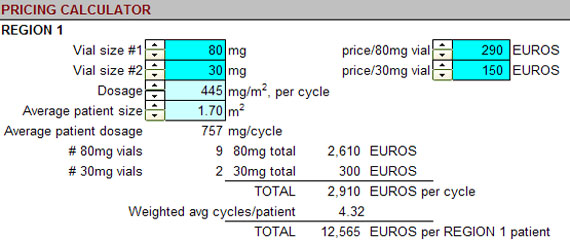|
Case Studies
This pharmaceutical revenue model case study is an aggregate of three
different chemotherapy products [real world, sanitized
data].
Once we have a robust
market model in place
and we have a good level of confidence in its projections,
we can begin to develop the revenue model. In the case
of pharmaceutical products, if the product being analyzed is
in early stage development, we may not know the dosing
schedule, amounts of the doses, or even the drug delivery
method. In these early stage cases we need to build a
flexible dosage and pricing calculator.
Below is an example of a cycles/cancer
patient calculator. In this case the product that we
analyzed had a targeted label for metastatic usage but may
garner some progressing patients [stage III to stage IV]
that needed to be accounted for and may actually receive
approval for earlier stage indications. Our calculator
tells us that weighted average cycles/patient is about
four-and-a-third.

Our next step is to unearth what kind of
revenues we would expect from a typical patient. This
step can get rather complex as we need to investigate our
method of drug delivery, the manufacturing protocols,
recommended dosage based on any number of criteria, and
expected pricing structure. Specifically, in the case,
you can see that we are manufacturing two different vial
sizes of the drug [80mg & 30mg]. Based on clinical
research and the expected indications approved we have a
dosage of 445 mg/square meter of body size per cycle.
The average body size in the region we have targeted is
approximately 1.70 meters squared. The calculator
returns the average patient dosage per cycle as 757 mg which
equates to nine 80 mg vials and two 30 mg vials of drug.
We have set the prices of the 80 mg and 30 mg vials at
290 EUROS and 150 EUROS, respectively.
We already calculated the weighted average cycles/patient at
4.32. We get our expected revenue per patient at 12,565
EUROS in this region.

The calculated revenue per patient is a
starting number. We now need to project revenue
changes over time due to competitive market forces, price
erosion or price premium adjustments, patent expirations and
the market entry of generics, and economies of scale.
Once we hammer out these effects on revenue, we can finish
the revenue model and have a high degree of confidence that
we are on the right track and can begin to integrate our
projected revenues into our
expense model.
|

